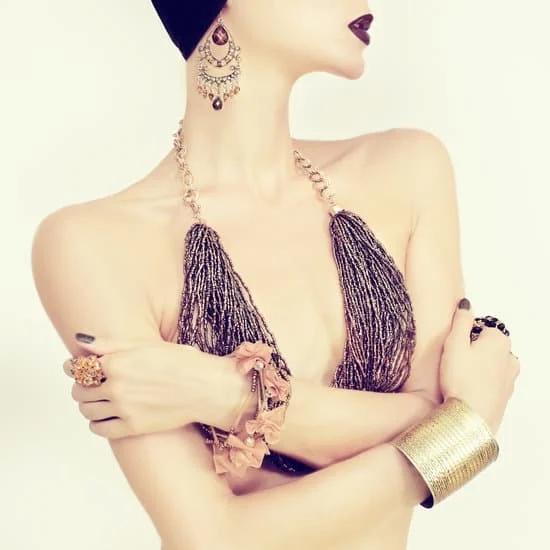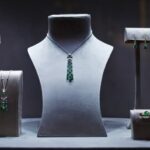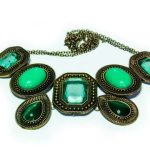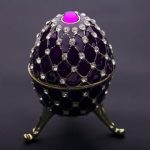Jewelry has been cherished and adorned by people for centuries, leading to the need for proper storage methods. In this article, we will delve into the history of jewelry boxes, exploring their evolution from ancient times to modern-day. From the basic need for practical storage to their cultural significance, jewelry boxes have played an important role in the preservation and display of precious jewels and accessories.
Since the early civilizations, humans have sought ways to store and protect their valuable jewelry pieces. The evolution of jewelry storage has been a testament to human creativity and ingenuity. From simple containers to intricately designed boxes, the history of jewelry boxes is a reflection of human innovation and craftsmanship.
In this article, we will explore how ancient civilizations stored their prized possessions, the development of jewelry boxes during the Middle Ages and Renaissance, and their symbolic role in the Victorian era. We will also take a closer look at modern-day jewelry boxes and their cultural significance in different parts of the world. Let’s journey through time as we uncover the fascinating history of jewelry boxes and their enduring legacy.
Evolution of Jewelry Storage
The history of jewelry boxes is a fascinating journey that traces back to ancient civilizations. Throughout the centuries, the evolution of jewelry storage has been influenced by cultural and technological advancements, resulting in the diverse and ornate designs we see today.
Ancient jewelry storage methods were often simple and functional, with early civilizations using organic materials such as wood, leather, and stone to create containers for their precious adornments. In ancient Egypt, for example, jewelry was often stored in elaborate wooden boxes or chests adorned with intricate carvings and precious metals. These artifacts not only served as storage but also held religious and symbolic significance.
During the Middle Ages, jewelry boxes took on a more practical role as the use of padlocks and ornate keys became popular for securing valuables. Jewelry caskets made from materials like iron and brass were common during this time, reflecting the influence of medieval craftsmanship and design.
The Renaissance period saw a resurgence of artistry and luxury in jewelry boxes. Intricate marquetry techniques were employed to create stunning patterns on wooden chests, while precious metals and gemstones were used to embellish these exquisite creations. The opulence of Renaissance jewelry boxes reflected the wealth and status of their owners, making them highly coveted pieces.
Ancient Jewelry Storage Methods
The history of jewelry boxes dates back to ancient times, when people first began to create and store precious jewelry. The evolution of jewelry storage has seen many different methods used, each reflecting the culture and technology of their time.
In ancient civilizations such as Egypt, Mesopotamia, and China, jewelry was often stored in elaborate containers made from materials such as wood, metal, or stone. These early jewelry boxes were designed not only to protect valuables but also to showcase the wealth and status of their owners. Some examples of ancient jewelry storage methods include:
- Egyptian Jewelry Chests: In ancient Egypt, jewelry was typically stored in chests made from wood or metal adorned with intricate carvings and colorful gemstones.
- Chinese Jade Caskets: In ancient China, jade was highly prized and often used to create exquisite caskets for storing jewelry. These caskets were often intricately carved with decorative motifs symbolizing luck and prosperity.
- Mesopotamian Lidded Vessels: In Mesopotamia, lidded vessels made from precious metals such as gold and silver were commonly used to store valuable items, including jewelry.
As craftsmanship advanced and trade routes opened up, new materials and techniques influenced the design of jewelry storage containers. The rich history of jewelry boxes provides a fascinating insight into the cultural values and aesthetics of each era. Throughout history, societies have continued to develop innovative ways to store and display their precious jewels.
Jewelry Boxes in the Middle Ages
During the Middle Ages, jewelry boxes were considered luxury items and were often owned by the wealthy and royalty. These jewelry boxes were usually handcrafted with intricate designs and adorned with precious gemstones. They served not only as a means to store valuable jewelry but also as a status symbol, showcasing the owner’s wealth and social standing.
In the Middle Ages, jewelry boxes were typically made from materials such as wood, metal, or ivory, and were ornately decorated with carvings, engravings, and inlays. Some of these boxes featured intricate lock mechanisms to safeguard their precious contents. The craftsmanship of these jewelry boxes was highly esteemed, with skilled artisans dedicating significant time and skill to create these extravagant storage pieces.
The style and design of medieval jewelry boxes reflected the artistic trends and cultural influences of the time period. For example, during the Gothic period, jewelry boxes often featured pointed arches, elaborate tracery, and religious motifs. In contrast, the Renaissance saw a revival of classical motifs and a focus on symmetry and proportion in the design of jewelry boxes. These historical influences continue to inspire modern-day jewelry box designs.
Renaissance and Jewelry Boxes
During the Renaissance, jewelry became an important aspect of one’s fashion and status, leading to the creation of more intricate and decorative jewelry boxes. This period marked a significant shift in not just the artistry of jewelry boxes, but also in terms of their functionality and symbolism.
Artistic Designs
The Renaissance era saw a surge in artistic expression, and this was reflected in the design of jewelry boxes. Artisans began incorporating intricate carvings, engravings, and ornate details into their creations. Many jewelry boxes were also adorned with precious stones, pearls, and other luxurious materials, reflecting the opulence of the time.
Functionality and Symbolism
During the Renaissance, jewelry boxes were not just used for storing valuable items; they also held symbolic meaning. Often given as gifts or passed down through generations, these boxes became heirlooms that represented wealth, power, and familial legacy. Jewelry boxes were designed to not only protect precious jewels but also to showcase them as a symbol of one’s social standing.
Influence on Modern Jewelry Boxes
The elaborate designs and rich symbolism seen in Renaissance-era jewelry boxes continue to influence modern jewelry box designs. The emphasis on both form and function remains a hallmark of these pieces today. Additionally, the cultural significance attached to jewelry boxes during the Renaissance has helped maintain their relevance over time as cherished objects that hold personal treasures and historical value.
Victorian Era and Jewelry Boxes
The Victorian Era was a period known for its opulence and elegance, and this was reflected in the design and use of jewelry boxes. During this time, jewelry boxes became increasingly ornate and decorative, often featuring intricate detailing and luxurious materials such as velvet, silk, and mother-of-pearl. The Victorians valued their jewelry as a symbol of status and wealth, and their jewelry boxes were designed to reflect this.
One iconic style of jewelry box that emerged during the Victorian Era was the trinket box. These small, delicate boxes were used to store tiny treasures such as rings, earrings, and lockets. Often adorned with delicate floral motifs or romantic scenes, trinket boxes became a popular gift choice for women during this time.
The rise of mass production during the Victorian Era also meant that more people had access to jewelry boxes. This led to a wider variety of styles and designs being available, catering to different tastes and budgets. As a result, jewelry boxes became not only a practical storage solution but also a decorative piece in their own right, adorning dressing tables and vanity units across the Victorian world.
| Victorian Jewelry Boxes | Trinket Boxes |
|---|---|
| Featured intricate detailing and luxurious materials | Used to store small treasures like rings and lockets |
| Became a symbol of status and wealth | Adorned with delicate floral motifs or romantic scenes |
| Became both practical storage solution & decorative piece in their own right | Became popular gift choice for women during Victorian era |
Modern Day Jewelry Boxes
In today’s modern world, jewelry boxes have evolved to not only protect and store valuable jewelry but also to reflect individual style and taste. Modern day jewelry boxes come in a variety of designs, materials, and features that cater to the diverse needs of consumers.
Design and Features
Modern jewelry boxes are designed with both functionality and aesthetic appeal in mind. They come in various shapes, sizes, and colors to suit different preferences. Some are equipped with specialized compartments, hooks, or drawers for organized storage of different types of jewelry such as rings, earrings, necklaces, and bracelets. Others may include built-in mirrors or intricate decorative details.
Materials
While traditional jewelry boxes were often made from wood or metal, modern versions can be crafted from a wide range of materials including glass, acrylic, leather, and even sustainable options such as bamboo or recycled materials. This diversity allows for more creativity in design and sustainability considerations.
Technological Advancements
Incorporating modern technology, some jewelry boxes now feature advanced security measures such as biometric locks or digital monitoring systems to ensure the safety of precious items. Additionally, there are also options for smart jewelry boxes that can help users keep track of their inventory or provide recommendations for coordinating jewelry pieces based on outfit choices.
With these developments in design and technology, modern day jewelry boxes continue to showcase innovation while still honoring the history of jewelry boxes as valuable containers for cherished belongings.
Cultural Significance of Jewelry Boxes
Throughout history, jewelry boxes have held significant cultural importance in various societies. These ornate containers not only served as a practical way to store and protect valuable jewelry and accessories but also held deeper symbolic meaning within different cultures. The history of jewelry boxes is intertwined with the customs, beliefs, and traditions of societies around the world.
In many ancient civilizations, jewelry boxes were used not only to store precious ornaments but also as offerings to deities or as burial items for the deceased. For example, in Ancient Egypt, jewelry boxes were often placed in tombs with the belief that these possessions would accompany the deceased into the afterlife.
Similarly, in China, elaborate jewelry boxes were considered an important part of traditional wedding ceremonies and were given as gifts to symbolize prosperity and good fortune for the newlyweds.
During the Victorian era, jewelry boxes became highly symbolic of social status and wealth. Intricately designed and often made from luxurious materials such as ivory or mother-of-pearl, these elaborately crafted jewelry boxes were not just a means of storage but also a display of opulence. They were commonly given as gifts to signify love and affection, making them an important part of courtship rituals during this period.
In modern times, the cultural significance of jewelry boxes has diversified with global influences and changing trends. From traditional wooden chests to contemporary glass cases, there is a wide range of styles and designs that reflect different cultural preferences and individual tastes.
Jewelry boxes continue to hold sentimental value as heirlooms passed down through generations or cherished gifts exchanged between loved ones on special occasions. The diverse cultural significance attached to these beautiful containers continues to evolve while preserving their historical importance.
Conclusion and Future of Jewelry Boxes
Jewelry boxes have a long and fascinating history, evolving from simple methods of jewelry storage in ancient times to elaborate, decorative pieces in the modern era. Throughout the ages, these boxes have not only been used for practical purposes but also held cultural significance. Looking back at the history of jewelry boxes provides insight into the artistry, craftsmanship, and societal values of each era.
The evolution of jewelry storage reflects changes in technology, fashion, and social customs. From the ancient Egyptians’ use of wooden or stone containers to the ornate, intricate designs during the Victorian era, jewelry boxes have seen significant transformations over time. As we move into the future, it will be interesting to see how advancements in materials and technology will continue to shape the design and functionality of these pieces.
In conclusion, the history of jewelry boxes is a testament to human creativity and ingenuity. These objects not only serve as practical storage for precious adornments but also hold cultural significance as symbols of wealth, status, and sentimentality.
Whether it’s a handmade wooden box passed down through generations or a modern electronic safe with biometric security features, jewelry storage will continue to be an essential part of human civilization. The future of jewelry boxes is likely to encompass both traditional craftsmanship and innovative technology, reflecting the ever-changing needs and tastes of society.
Frequently Asked Questions
Where Did Jewelry Boxes Originate?
Jewelry boxes have been around for centuries and their origins can be traced back to ancient Egypt. The Egyptians used small, intricate boxes to store their precious jewelry and other valuable items.
What Is the Significance of a Jewellery Box?
The significance of a jewelry box lies in its ability to protect and organize precious jewelry pieces. It also adds a touch of elegance and sophistication to the act of storing and presenting jewelry, making it more than just a functional item.
What Are Some Facts About Jewellery Boxes?
Jewelry boxes come in a variety of styles, materials, and sizes, catering to different tastes and needs. Some are simple and utilitarian, while others are ornate and decorative.
They can be made from wood, metal, leather, or even glass, offering options for every individual’s style preferences. Additionally, many jewelry boxes come with special compartments or organizers designed to keep different types of jewelry separate and prevent tangling or damage.

Welcome to my jewelry blog! My name is Sarah and I am the owner of this blog.
I love making jewelry and sharing my creations with others.
So whether you’re someone who loves wearing jewelry yourself or simply enjoys learning about it, be sure to check out my blog for insightful posts on everything related to this exciting topic!





